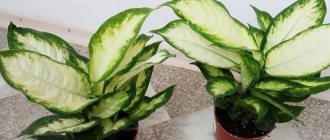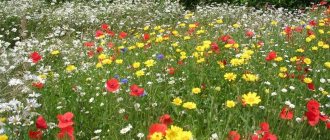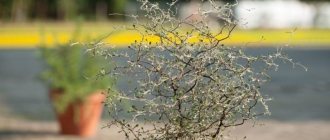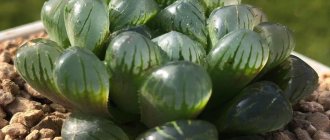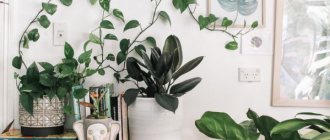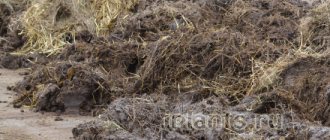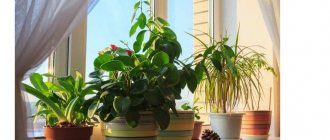Caution - flowers
It turns out that the harmful properties of some indoor flowers can have a negative impact on people's health.
Perhaps you have noticed that after receiving a gift your health suddenly begins to deteriorate? You need to be especially careful when buying a green resident if there are small children or animals in the house. The sap of some types of green plants contains dangerous poison or they release very toxic substances into the air.
But not only greenery is not recommended to be kept at home, but also many beautiful flowers popular among gardeners. If you cannot refuse their content, then try to find the right location for them. They should not be placed in the bedroom, or maybe even in the kitchen.
There is constant debate among gardeners about the dangers of some plants. Mixed in with the disagreements are a variety of signs that can intimidate even an experienced gardener, not to mention beginners.
This article will help you figure out which flowers should not be kept in the house and which plants you need to be careful with due to possible consequences for human health and energy.
Ivy.
Ivy has poisonous all parts of the plant, from the leaves to the fruits. A lot of controversy arises about this plant. As for the poisonousness of ivy—namely, its juice—scientists are divided into three camps. Some argue that the juice contains a resin - urshiolya, some that it is not a resin, but a derivative of phenol, and some even believe that Ivy juice is rich in toxicodendrolic acid. But scientists agree on one thing - its juice is still poisonous and can cause burns and poisoning.
List of poisonous plants
This list includes those types of indoor plants with photos that are best avoided, especially if there are small children or pets in the house. Concerns arise due to the excessively dangerous properties of green spaces.
A baby, dog or cat may be attracted to the beautiful flowers of a dangerous plant, from which they can get severe burns or even be poisoned by poisonous juice.
If you have neither children nor animals, but do have such plants, then be very careful when caring for them:
- Be sure to wear gloves when handling these flowers.
- Wash your tools after use.
- Do not trim flowers or leaves with the knife you use in the kitchen.
Geranium
Yes, we didn't mix anything up. This plant is, of course, very useful. On the one hand, geranium is an excellent antiseptic, helps relieve stress and tension, and relieves pain from otitis media and sore throats. However, there are people for whom the smell of geranium can trigger a severe asthma attack and cause an allergic reaction. Geranium (as one of the poisonous indoor flowers) is also contraindicated for pregnant women, people with low blood sugar, young children and those taking birth control.
Group of dangerous plants
Dieffenbachia
This popular plant can be found in many homes. Florists are attracted by its huge yellow-green leaves, which form a crown that impresses the imagination.
Why can’t you keep Dieffenbachia in an apartment? The sap of the plant, which splashes when cutting the stem or leaves, is toxic. If a child or a pet takes a leaf of this flower into their mouth, its juice can cause quite noticeable poisoning.
In addition, the juice of this green pet causes burns and unpleasant redness on the skin.
Oleander (Nerium oleander)
Flower growers are attracted by bright crimson flowers, so it grows in many homes. But if oleander juice enters the human or animal body, it can cause blindness.
And the smell of a flowering plant can make you dizzy or make you feel unwell.
Euphorbia (Euphorbia)
This plant has so many species and varied forms that it is impossible to describe it unambiguously. Many species are very similar in appearance to cacti with spines, the injection of which is dangerous for people and animals.
The leaves and stems of milkweed contain white juice that can cause burns and irritation on the skin, and if ingested, cause poisoning.
Croton
This potted plant belongs to the Euphorbiaceae family and looks like a small tree with variegated, elongated leaves. At home it hardly blooms.
Croton juice is dangerous. It can cause burns on the skin, and if ingested or cut into the blood, it can lead to intensive care or even death.
Azalea
A very popular species among home gardening enthusiasts. It is loved for its lush flowering. Azalea blooms pink, white, red and yellow flowers.
The most dangerous is Azalea Simsa (Indian Azalea). If particles of its leaves enter the body, convulsions or intestinal colic may begin.
Mimosa pudica
A bizarre green organism. It is a thin stalk with small delicate, fragile leaves. Its behavior is very interesting: as soon as you touch it, its leaves roll into a tube.
It is not recommended to contact mimosa for a long time. This may result in hair loss. Sometimes a person becomes completely bald. And the whole point is its toxic substances that poison the human body.
Evergreen ivy (Hedera)
The shrub in the form of vines belongs to the Araliaceae family. Cats love him very much. They are attracted to bright green leaves and berries, after playing with which the animal can become poisoned and even die from severe poisoning.
Adenium
It is loved for its beautiful appearance, represented by a powerful stem similar to a tree trunk. At its top there are sparsely growing leaves and a large number of flowers of a delicate pink color, of medium size.
The toxic sap of the plant is very dangerous and can cause severe burns on the skin and even severely poison the body.
Monstera
The spectacular monstera is not considered a very dangerous species, but it is not recommended to keep it at home.
Most often, monstera is placed in public places or botanical gardens, as it is endowed with leaves of impressive size. Green giant juice can cause burns on the skin, indigestion if ingested, and damage to the eyes.
Philodendron
Classified as belonging to the aroid family. These can be vines, bushes with lush greenery. Poisonous philodendron sap in contact with skin and eyes can cause burns and irritation.
Primula
This flower is incredibly popular among gardeners. Thanks to its small size, lush flowering in a variety of shades and velvety foliage, primrose has become a favorite of many gardeners. Lovers of home gardening decorate all the rooms of their homes with it.
But not everyone knows that when flowering, primrose releases harmful substances that can cause dizziness and nausea. And contact with velvety foliage, covered with small fibers, leads to allergies and redness.
Stellera chamaejasme
Stellera is famous for its medicinal properties, but they can only be used on the recommendation and under the supervision of a doctor.
The flower itself has a tall stem with inflorescences consisting of 20-30 small white flowers. If pieces of foliage enter the body, this can lead to numbness or swelling of the vocal cords.
Nightshade (Solanum)
It captivates with its bright orange fruits, which grow together on an evergreen shrub. It is these elegant berries that are considered extremely dangerous and poisonous.
The bright color of the fruit irresistibly attracts children and pets. It is better not to grow this flower at home, so as not to get into trouble.
Gesner's tulip (Tulipa gesneriana)
This species blooms very beautifully. A marvelous flower blooms on a medium-sized stem, with a variety of colors - from yellow to red.
It is important to remember that staying near this beautiful flower for a long time is not recommended. This can lead to baldness or partial hair loss.
Trichocereus
This is a type of cactus. Trichocereus has long needles, it blooms with rather large snow-white flowers that have a pleasant smell. But a pleasant aroma can lead to hallucinations or even paralysis of the nervous system.
Dieffenbachia.
Dieffenbachia is another plant familiar to us, which, unfortunately, contains alkaloids that, if any part of the plant is damaged, can cause burns and cause swelling and allergic reactions . As a rule, irritation does not appear on the skin immediately, but after some time.
This is interesting! In slave-owning Brazil, Dieffenbachia was used to punish guilty slaves. They were forced to eat a Dieffenbachia leaf, after which the slaves experienced swelling of the tongue and larynx. In this state they could not talk, which is why this method of punishment in Brazil was called silent rods.
Difference by family
The list of poisonous plants is much longer, so when making a green purchase, immediately ask which family a particular plant belongs to. There are 4 main families of the most dangerous and harmful indoor plants for humans and animals:
- Euphorbiaceae family. The juice of many representatives of this species is dangerous. It causes burns on the skin.
- Family Araceae. The juice of most representatives of this group is toxic.
- Kurt family. This group includes the most dangerous plants for human and animal health. They are endowed with a particularly elegant look. When working with these flowers, be sure to wear gloves.
- Solanaceae family. In this group, not all plants are considered poisonous, because potatoes and tomatoes belong specifically to this class. But the flowers that many people buy for home are most often dangerous, especially their fruits, which cause indigestion, nausea, and vomiting.
In parting, I would like to wish you to be careful when choosing flowers for yourself or a green gift for your friends.
Read further:
Folk signs: why you can’t keep a rose at home
The most unpretentious home flowers for home, balcony and office
What do flowers mean in a bouquet: signs, symbols, etiquette
What flowers are suitable for a luxurious balcony?
What plants should not be planted nearby on the site?
11 flowers that bring good luck to your home
Adenium.
Adenium is an incredibly beautiful indoor plant, which is striking in its unusualness: a thick trunk, which in skillful hands takes the form of a cute bonsai, and stunning flowers. However, today Adenium is considered perhaps the most poisonous indoor plant. In Adenium, all parts of the plant are poisonous, including the juice. In addition, Adenium is quite toxic and can be harmful to people with asthma.
This is interesting! African tribes use Adenium juice to poison arrowheads
Fern
Various variations of ferns are quite often the basis of a winter garden: they are really very beautiful and can turn any room into a real enchanted forest! There is also an opinion that fern can protect a house from evil spirits and reconcile the people living in it. Unfortunately, all these magical properties will have to be abandoned if allergy sufferers live in the apartment.
Castor bean
Among the plants that cannot be kept at home, castor beans should occupy one of the first places. This plant is usually grown outdoors in gardens, but some gardeners prefer to have it at home. The houseplant is valued for the beauty of the shape of its leaves, which have a dark purple color. However, castor bean seeds are very poisonous. If you chew or swallow such a seed, a person develops gastroenteritis and dehydration occurs due to diarrhea and vomiting. The liver and kidneys are also affected. Castor bean poison is one of the most powerful known biological poisons. So, one castor bean seed can kill a cat, two can kill a dog or a child, three or four will lead to the death of an adult.
The toxicity of castor bean seeds is associated with the protein ricin, which is present in them. Once in the body, this protein reacts with the cell’s ribosomes and interferes with protein synthesis. This leads to the death of cells and, as a consequence, the entire organism.
It is interesting to note that the oil obtained from castor bean seeds is one of the best laxatives. When preparing this product, it is subjected to heat treatment, which leads to the destruction of the poisonous ricin.
Currently, castor bean seed oil is used in the industry in the production of paints, varnishes and lubricants for automobile brake systems.
Ficus
At first glance, ficus is a rather harmless and even boring plant, which is usually placed in impressive tubs in offices. Meanwhile, at night it insidiously absorbs oxygen, so proximity to a ficus is unacceptable in a small bedroom. Also, you should not place it in the nursery: who knows what such oxygen “greed” of the plant will lead to.
Trichocereus cactus
Growing Trichocereus cactus as indoor plants has become a fashion in recent years. The cacti themselves grow naturally in the western part of the Andes, in South America, at an altitude of 2-3 km above sea level. They grow quickly and are quite unpretentious. However, this plant is not harmless to humans.
Why is Trichocereus cactus dangerous? Its stem contains the alkaloid mescaline, which is a strong hallucinogenic and psychotropic substance. It is known that in ancient times the Indians used this substance, extracted from a cactus, as a way to put a person into a trance during their pagan rituals. When mescaline enters the body, the first symptoms begin to appear within 1 hour: nausea and vomiting. After 2-4 hours, a person experiences a feeling of euphoria, profuse sweating, visual hallucinations, confusion, and sudden mood changes. These symptoms may last up to 12 hours after eating cactus parts. If ingested in large quantities, mescaline can cause paralysis of the central nervous system.
Scientific research is currently underway to elucidate the mechanism of action of mescaline on the human nervous system. This chemical compound is not used for medical purposes.
Oleander
If you have watched the movie “White Oleander”, then you probably know how much evil lurks in this delicate plant: oleander flowers are very poisonous, but their danger does not end there. Even their aroma can cause dizziness, especially if you keep the oleander indoors in winter. Therefore, it is better to replace this flower with something more harmless.
Which ones can you start?
In principle, there are no strict restrictions for indoor plants. You can have any flower you like, the main thing is to choose a suitable place for it and follow safety precautions.
However, the most favorable inhabitants of a living space are plants that purify the air and do not pose any danger. These include:
- Begonia;
- bamboo;
- Crassula;
- violets;
- Sansevieria;
- lemon;
- Kalanchoe.
All these plants will help create coziness in any room, complement the design, refresh the interior and purify the air in the room.
Rate this post
Which ones are better not to keep in the apartment?
The flowers listed above are undesirable for an apartment. In addition, the following categories of flora representatives will become undesirable residents for small apartments:
- Woody plants - they take up a lot of space and can fall over. If it falls on a child, it can cause serious injury.
- Spiny plants - including cacti. It’s not so scary if a person simply injects himself, but sometimes a cactus can shoot a thorn into the eye - the consequences will be very serious.
- Flowers in fragile pots - they always have a chance of breaking. The fragments can injure both an adult and a child or animal.
Important! It is also undesirable to grow indoor trees in an apartment for the reason that sooner or later they will reach the height of the ceiling. Many are sensitive to pruning. Therefore, it is worth assessing the prospects for growing the selected species in advance.
In the bedroom
Certain plants should not be placed in the bedroom (for various reasons). Some of them consume too much oxygen when breathing, creating a stuffy atmosphere. Others release stimulants into the air that will disrupt sleep.
You should refrain from using the following types in the interior:
- Ficus;
- indoor lilies;
- Orchids;
- Oleander;
- Ferns;
- Monsters.
If you want to grow these plants, you should place them in other rooms with good ventilation. For example, in the living room or kitchen.
In the nursery
For the nursery, the same prohibitions apply as for the bedroom - children do not need either stuffiness at night or excessive excitement. However, in addition to this, you should not use poisonous varieties for a children's room. After all, then if you neglect the baby a little, he will end up in the hospital with poisoning or burns.
Therefore, in addition to the types listed above, the following types cannot be placed in the children's room:
- Poinsettia;
- Jatropha;
- Adenium;
- Solyanum;
- Aroid.
Important! When designing a children's room, you should also remember the danger that cacti pose - their spines can be fatal for children.
Before placing flowers in a child's room, you need to carefully study the information about them to find out whether they pose a danger. It is necessary to additionally take into account the layout of plants in the nursery. It is important to organize the space so that the child cannot drop the flower and break the pot, because ceramic shards cause serious damage.
